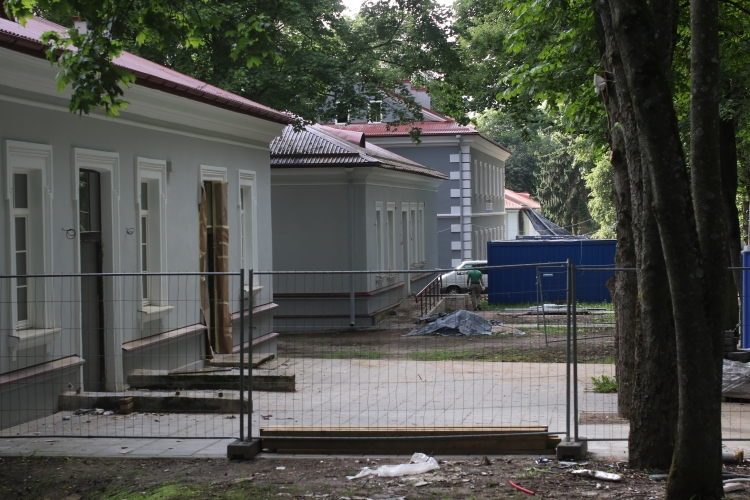 In Sapiegos park, which once was the manicured baroque entrance to the Sapiegos palace, a major change is around the corner. The park is lined with clusters of old buildings, which a year ago were little more than ruins of the old Russian-era hospital that took over the palace after it fell out of the hands of the Sapieha family. But over the year, the buildings in this corner of Antakalnis, a short bus ride from the centre, have been spruced up, and signs that went up recently announced a somewhat unusual tenant for the heritage-listed site: Vilnius Tech Park. The buildings, are intended to form part of the ongoing bid for Vilnius to become a major hub for digital technology, and their cluster formation and human scale make them ideal for a collaborative research and development space. I would imagine that visitors, expecting a space-age glass-and-steel site will be surprised to arrive in a 1800s milieu steeped in history, but again, this would be one of the occasions when Vilnius gets the marriage of old and new just right.
In Sapiegos park, which once was the manicured baroque entrance to the Sapiegos palace, a major change is around the corner. The park is lined with clusters of old buildings, which a year ago were little more than ruins of the old Russian-era hospital that took over the palace after it fell out of the hands of the Sapieha family. But over the year, the buildings in this corner of Antakalnis, a short bus ride from the centre, have been spruced up, and signs that went up recently announced a somewhat unusual tenant for the heritage-listed site: Vilnius Tech Park. The buildings, are intended to form part of the ongoing bid for Vilnius to become a major hub for digital technology, and their cluster formation and human scale make them ideal for a collaborative research and development space. I would imagine that visitors, expecting a space-age glass-and-steel site will be surprised to arrive in a 1800s milieu steeped in history, but again, this would be one of the occasions when Vilnius gets the marriage of old and new just right.
Category Archives: Streets and buildings
Seimas – landmark with a small ‘l’
 Getting major symbolic public buildings designed right is a daunting challenge, and for parliamentary buildings, the stakes are doubled. Some have managed to create stunning houses for the heart of democratic power. The Houses of Parliament in London are a work of art. The Budapest Parliament is not only grand, but sitting on the banks of the danube, absolutely gorgeous. In fact, most of the usually colonnaded oeuvres that house the elected representatives of the people exude power, but also invite you in. And when their design is more contemporary, like in Norway, the design is nevertheless striking and memorable. In Lithuania, the Seimas Palace is not really scoring high on any of those counts. It is admittedly big, and has a wide apron around it to let it ooze some pomp, but its 1976 soviet-era design just doesn’t cut it. It looks more like a dated museum or public archives than the seat of government. Of course, for Lithuanians, the building is highly charged with symbolism, even if the architecture is a bit lacking. This was the twin site where the “January events” of 1991 unfolded, alongside the striking TV tower of Vilnius. On the Western flank of the building, a glassed-in exhibition has preserved some of the concrete blocks and barbed wire that was used to stop Soviet troops from claiming the parliament. For that reason alone, the building will never be re-vamped in a more grandiose style that reflects its central role in government, and the exhibition is a worthwhile detour en route to Žvėrynas or if you’re on a Neris riverside walking tour of the city.
Getting major symbolic public buildings designed right is a daunting challenge, and for parliamentary buildings, the stakes are doubled. Some have managed to create stunning houses for the heart of democratic power. The Houses of Parliament in London are a work of art. The Budapest Parliament is not only grand, but sitting on the banks of the danube, absolutely gorgeous. In fact, most of the usually colonnaded oeuvres that house the elected representatives of the people exude power, but also invite you in. And when their design is more contemporary, like in Norway, the design is nevertheless striking and memorable. In Lithuania, the Seimas Palace is not really scoring high on any of those counts. It is admittedly big, and has a wide apron around it to let it ooze some pomp, but its 1976 soviet-era design just doesn’t cut it. It looks more like a dated museum or public archives than the seat of government. Of course, for Lithuanians, the building is highly charged with symbolism, even if the architecture is a bit lacking. This was the twin site where the “January events” of 1991 unfolded, alongside the striking TV tower of Vilnius. On the Western flank of the building, a glassed-in exhibition has preserved some of the concrete blocks and barbed wire that was used to stop Soviet troops from claiming the parliament. For that reason alone, the building will never be re-vamped in a more grandiose style that reflects its central role in government, and the exhibition is a worthwhile detour en route to Žvėrynas or if you’re on a Neris riverside walking tour of the city.
Who’s Rupert?
 Overlooking the Neris river, nestled in a birch grove at the edge of the “second” beach in Valakampiai, is a place called Rupert. The website of the place labels it “A knowledge-based platform for innovative creative production” – which is a complicated way of saying a retreat for literary and artsy types. The striking building, which is clad entirely inside and out in bleached pine, was designed by Audrius Ambrasas architects, a Lithuanian outfit, which claims that the box blends into the pine forest behind it. However they want to put it, it is undeniable that Rupert somehow symbolises a lot of the creative energy buzzing around Vilnius at is strives to garner a reputation as a contemporary and modern hub for a new wave of creative talent in Europe. And if you’re one of the artists considering a residency, rest assured that the beach next to it is excellent.
Overlooking the Neris river, nestled in a birch grove at the edge of the “second” beach in Valakampiai, is a place called Rupert. The website of the place labels it “A knowledge-based platform for innovative creative production” – which is a complicated way of saying a retreat for literary and artsy types. The striking building, which is clad entirely inside and out in bleached pine, was designed by Audrius Ambrasas architects, a Lithuanian outfit, which claims that the box blends into the pine forest behind it. However they want to put it, it is undeniable that Rupert somehow symbolises a lot of the creative energy buzzing around Vilnius at is strives to garner a reputation as a contemporary and modern hub for a new wave of creative talent in Europe. And if you’re one of the artists considering a residency, rest assured that the beach next to it is excellent.
Lithuania’s only hairpins
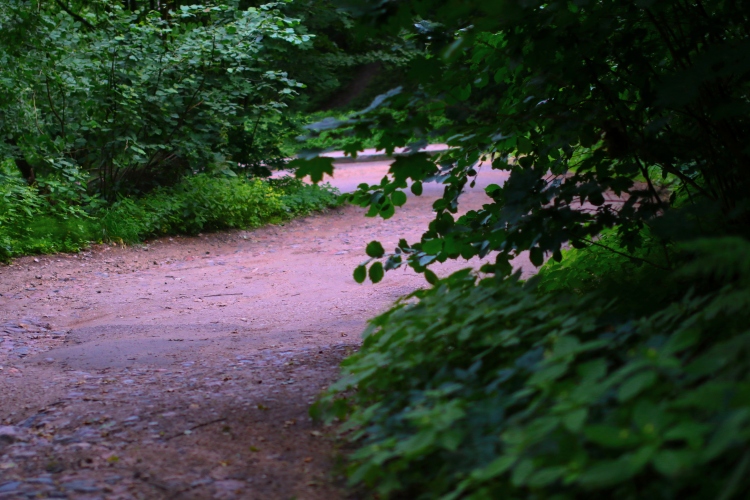 Serpentine roads can be stunning, winding their way up alpine slopes offering a topsy-turvy view of gorgeous mountain landscapes. They can also be less spectacular, and in a flat country like Lithuania, this is the case for the only serpentine road in country, in the Eastern suburbs of Vilnius. It has three hairpin bends, and is in a landscape that is so overgrown with undergrowth and bushes that it is impossible to capture on camera in summertime, even with the restrictions of a long lens like this one. The road is in pretty bad shape, and is not easy to find, tucked away deep in a residential quarter far away from main roads. The easiest way to find it is to go past the Markučiai manor on the Pavilniai road that snakes into the regional park across the river from Belmontas. Follow the road until you cross the Vilnius-Minsk rail line, and take the first road to the left. After passing a string of wooden houses, the bends start to climb the last bit of the ridge that marks the top of the Vilnia valley. It is not worth going out of your way for a weekend visitor, but it does offer a roundabout way to get to some interesting sights in the Pavilniai regional park, so if you’re on a bike, it’s not a bad waypoint. It is also evident that I’ve started to run out of material for this blog, but that is just as well because it’s all wrapping up soon and I’ve saved some of the best for last, so stay tuned!
Serpentine roads can be stunning, winding their way up alpine slopes offering a topsy-turvy view of gorgeous mountain landscapes. They can also be less spectacular, and in a flat country like Lithuania, this is the case for the only serpentine road in country, in the Eastern suburbs of Vilnius. It has three hairpin bends, and is in a landscape that is so overgrown with undergrowth and bushes that it is impossible to capture on camera in summertime, even with the restrictions of a long lens like this one. The road is in pretty bad shape, and is not easy to find, tucked away deep in a residential quarter far away from main roads. The easiest way to find it is to go past the Markučiai manor on the Pavilniai road that snakes into the regional park across the river from Belmontas. Follow the road until you cross the Vilnius-Minsk rail line, and take the first road to the left. After passing a string of wooden houses, the bends start to climb the last bit of the ridge that marks the top of the Vilnia valley. It is not worth going out of your way for a weekend visitor, but it does offer a roundabout way to get to some interesting sights in the Pavilniai regional park, so if you’re on a bike, it’s not a bad waypoint. It is also evident that I’ve started to run out of material for this blog, but that is just as well because it’s all wrapping up soon and I’ve saved some of the best for last, so stay tuned!
Cretaceous critters
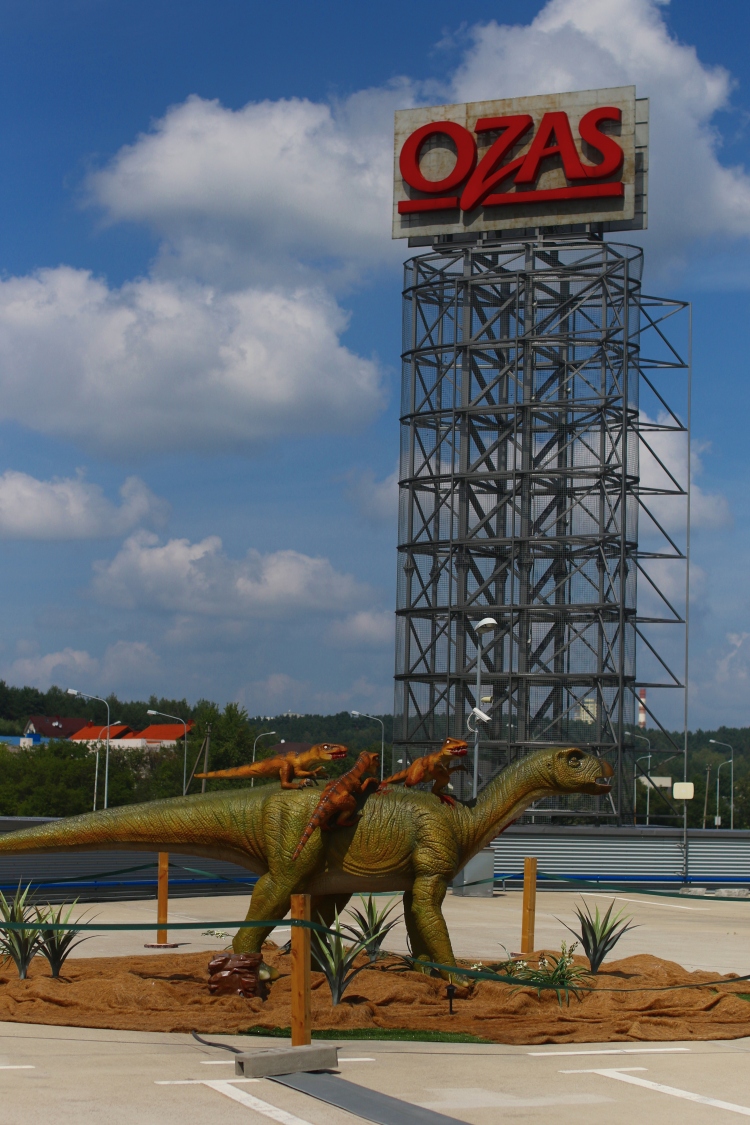 Since 22 July, Vilnius has been treated to one of the most bizarre attractions yet – Dino.lt Park Ozas. Baking in the scorching sun on the sprawling top floor of the massive parking lot of shopping centre Ozas in the suburbs north of Vilnius, Dino.lt is an animatronic dino-stravaganza. The rubber-encased robots are built to scale, and under each is a loudspeaker screeching plausible dinocoustics. If you get bored with the oversized jurassics, there’s also a huge playground made of plastic and a bouncy castle, and there is the obvious ice cream stand next to the entrance. Kids pay 7 euros and adults 8, which would seem to suggest that grownups somehow have a greater willingness to pay than kids for this particular attraction. Kids under 2 get in for free – if they manage to get past the screeching head of a triceratops that pops out of a hole next to the cashier, without being reduced to tears. If you’re not that into dinos, at least you get a nice view of the motorway, and a chance to work on the summer tan.
Since 22 July, Vilnius has been treated to one of the most bizarre attractions yet – Dino.lt Park Ozas. Baking in the scorching sun on the sprawling top floor of the massive parking lot of shopping centre Ozas in the suburbs north of Vilnius, Dino.lt is an animatronic dino-stravaganza. The rubber-encased robots are built to scale, and under each is a loudspeaker screeching plausible dinocoustics. If you get bored with the oversized jurassics, there’s also a huge playground made of plastic and a bouncy castle, and there is the obvious ice cream stand next to the entrance. Kids pay 7 euros and adults 8, which would seem to suggest that grownups somehow have a greater willingness to pay than kids for this particular attraction. Kids under 2 get in for free – if they manage to get past the screeching head of a triceratops that pops out of a hole next to the cashier, without being reduced to tears. If you’re not that into dinos, at least you get a nice view of the motorway, and a chance to work on the summer tan.
Afganai restitution
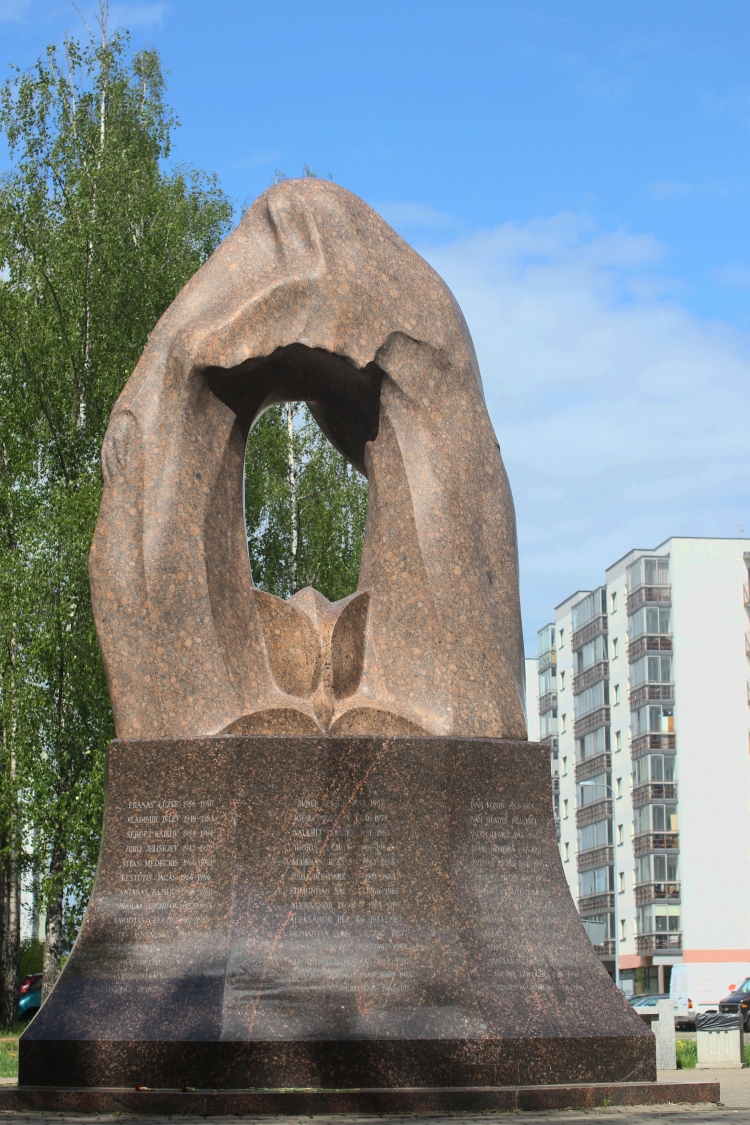 Hidden away in the Žirmūnai district in North Vilnius, squeezed between shopping centres, business parks, modern apartment blocks and crumbling Red Army barracks, is an unassuming granite sculpture dedicated to the “Afganai” – the 96 Lithuanians that died among the 4,000 Soviet casualties in the disastrous USSR invasion of Afghanistan, for which the central Asian country is still paying a heavy price today. The formless sculpture of two weeping, veiled women was put in place in 2006, but before then the afganai veterans had suffered considerably. The Soviet regime, which collapsed shortly after the Afghan invasion came to an end in 1989, kept a lid on the war, and left its veterans, including the 98 Lithuanians injured in the war, to look after themselves. Unsurprisingly, they received little understanding or support from a population unaware of what they had been through. Once the truth was revealed, the veterans bore the brunt of the vitriol directed at the war in the country, again, without any state support to speak of. This sculpture at least serves as recognition of their plight, and has been erected “on behalf of the children of the future.”
Hidden away in the Žirmūnai district in North Vilnius, squeezed between shopping centres, business parks, modern apartment blocks and crumbling Red Army barracks, is an unassuming granite sculpture dedicated to the “Afganai” – the 96 Lithuanians that died among the 4,000 Soviet casualties in the disastrous USSR invasion of Afghanistan, for which the central Asian country is still paying a heavy price today. The formless sculpture of two weeping, veiled women was put in place in 2006, but before then the afganai veterans had suffered considerably. The Soviet regime, which collapsed shortly after the Afghan invasion came to an end in 1989, kept a lid on the war, and left its veterans, including the 98 Lithuanians injured in the war, to look after themselves. Unsurprisingly, they received little understanding or support from a population unaware of what they had been through. Once the truth was revealed, the veterans bore the brunt of the vitriol directed at the war in the country, again, without any state support to speak of. This sculpture at least serves as recognition of their plight, and has been erected “on behalf of the children of the future.”
Medieval design with fresh brickwork
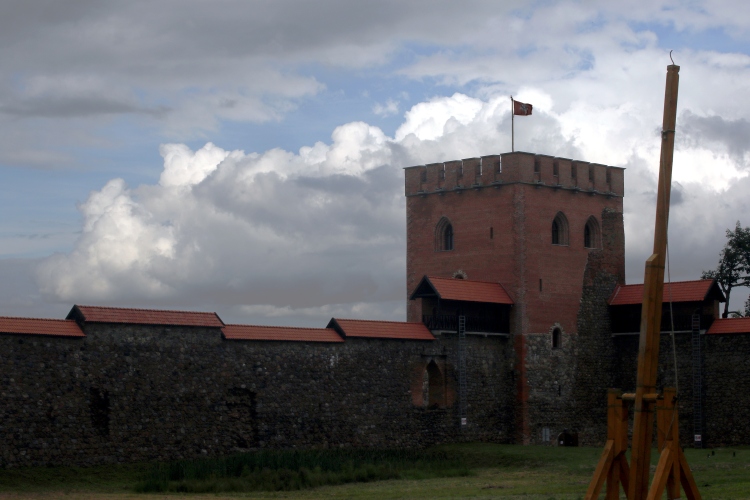 Driving the snaking and picturesque route along the Lithuanian border with Belarus stands the fantastically grand Medinikai castle, towering in the highlands on the “roof” of Lithuania. The castle is owned by the Trakai History Museum, but Medininkai is practically unkown – as opposed to Trakai which features on practically every postcard in Lithuania. The castle’s watchtower was rebuilt in 2012 (the CE mark on the bricks give away the fact that this was no centuries-old craftsmanship) and now houses a five-storey museum on the castle’s history, and from the top you can see across to Belarus just a stones’ throw to the East, and the gently rolling hills of wheat and flax. For a more authentic knights-and-armour medieval experience, Medininkai is definitely preferable to Trakai. Also the complete absence of souvenirs, tat, and castle-related commerce around the site is refreshing. It may be worth checking the castle’s website to see if there’s a battle re-enactment scheduled, since that would certainly make for an unforgettable visit. While you’re there, it’s worth popping by Aukštojas hill – Lithuania’s highest alp at 294 metres, marked by a stone and a viewing tower at the edge of a forest a few minutes south of Medininkai. And it’s all just a little over half an hours’ drive from Vilnius.
Driving the snaking and picturesque route along the Lithuanian border with Belarus stands the fantastically grand Medinikai castle, towering in the highlands on the “roof” of Lithuania. The castle is owned by the Trakai History Museum, but Medininkai is practically unkown – as opposed to Trakai which features on practically every postcard in Lithuania. The castle’s watchtower was rebuilt in 2012 (the CE mark on the bricks give away the fact that this was no centuries-old craftsmanship) and now houses a five-storey museum on the castle’s history, and from the top you can see across to Belarus just a stones’ throw to the East, and the gently rolling hills of wheat and flax. For a more authentic knights-and-armour medieval experience, Medininkai is definitely preferable to Trakai. Also the complete absence of souvenirs, tat, and castle-related commerce around the site is refreshing. It may be worth checking the castle’s website to see if there’s a battle re-enactment scheduled, since that would certainly make for an unforgettable visit. While you’re there, it’s worth popping by Aukštojas hill – Lithuania’s highest alp at 294 metres, marked by a stone and a viewing tower at the edge of a forest a few minutes south of Medininkai. And it’s all just a little over half an hours’ drive from Vilnius.
Third Baltic sister goes to Brussels
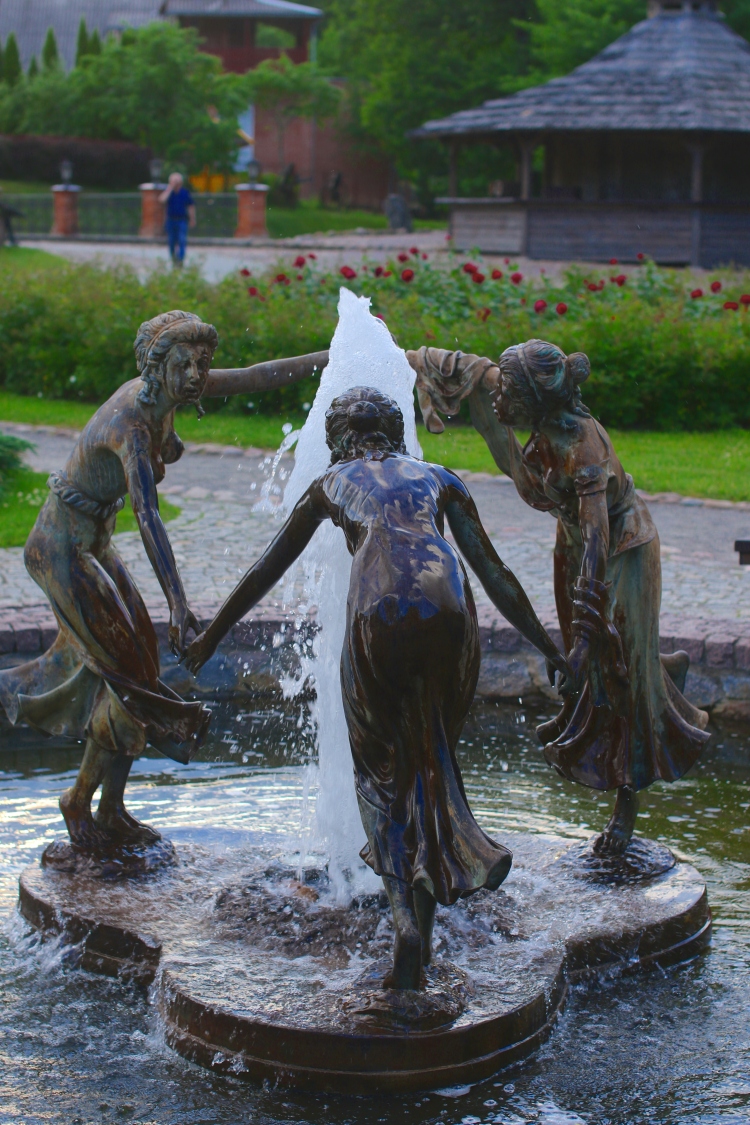 So one of the more immediate effects of the shocking UK referendum to quit the most successful project in cohesion, prosperity and peace in living memory is that Estonia, the Baltic ‘little sister’ (1.3m Estonians, compared to 2m Latvians and 3m Lithuanians) gets to chair the rotating EU presidency six months earlier than foreseen. As a result, the three Baltic states will have held their successive presidencies – in reverse order – in a short amount of time, imprinting some Baltic spirit into the union. Whatever you might say about the importance of the presidency itself, it does offer the holder an opportunity to show off their country for six months, and an excuse to spruce up their main sights and landmarks. Lithuania’s motto when it held the presidency in late 2013 was focused on ‘growth’ – an EU catchphrase that was all the rage as people tried to figure out how to shake off the financial crisis. Latvia, which held the presidency in early 2015, branded its presidency as the “honest” one, with plenty of the trademark Baltic marketing brand of pagan harvest symbols, lots of trees and tech-savvy flair. Estonia’s challenge in one years’ time will be to complete the Baltic brand at a time when the EU is trying to heal the wound of its impending departing member (pun-intention optional), but being the most economically successful of the three, it will likely carry more clout in the corridors of Brussels than its predecessors. As for the three sisters’ relationships with each other, I’m left scratching my head, but that perplexing thought will have to wait until another post.
So one of the more immediate effects of the shocking UK referendum to quit the most successful project in cohesion, prosperity and peace in living memory is that Estonia, the Baltic ‘little sister’ (1.3m Estonians, compared to 2m Latvians and 3m Lithuanians) gets to chair the rotating EU presidency six months earlier than foreseen. As a result, the three Baltic states will have held their successive presidencies – in reverse order – in a short amount of time, imprinting some Baltic spirit into the union. Whatever you might say about the importance of the presidency itself, it does offer the holder an opportunity to show off their country for six months, and an excuse to spruce up their main sights and landmarks. Lithuania’s motto when it held the presidency in late 2013 was focused on ‘growth’ – an EU catchphrase that was all the rage as people tried to figure out how to shake off the financial crisis. Latvia, which held the presidency in early 2015, branded its presidency as the “honest” one, with plenty of the trademark Baltic marketing brand of pagan harvest symbols, lots of trees and tech-savvy flair. Estonia’s challenge in one years’ time will be to complete the Baltic brand at a time when the EU is trying to heal the wound of its impending departing member (pun-intention optional), but being the most economically successful of the three, it will likely carry more clout in the corridors of Brussels than its predecessors. As for the three sisters’ relationships with each other, I’m left scratching my head, but that perplexing thought will have to wait until another post.
Die-hard sanctuary in Aukštaitija
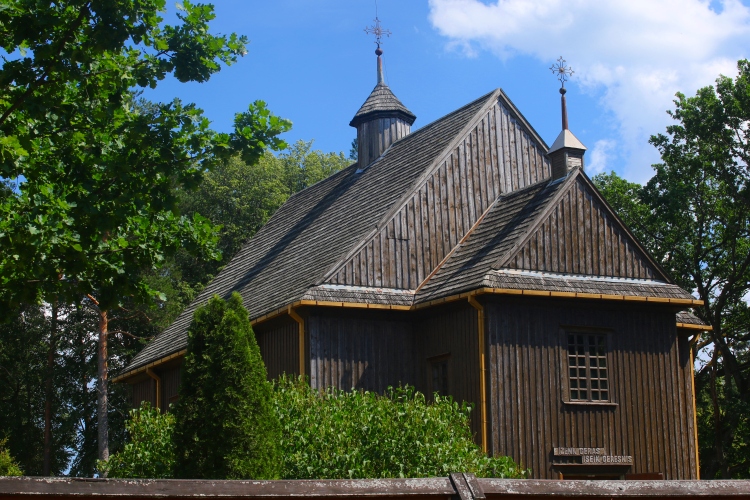 Among the many landmarks in Lithuania, the wooden church of St. Juozapas in Palūšė must count as one of the more extraordinary. Built around 1750 it is said to be the oldest church in Lithuania that still clings on to its original design, and stands in the capital of the lake-filled Aukštaitijos national park, about one and a half hours North-East of Vilnius. What is particularly remarkable is that this relatively humble edifice, which has seen some of Europe’s most deadly wars ravage past its doors, not to mention regimes hostile to anything to do with religion, is made entirely from wood, and still has managed to escaped being set alight, pillaged or demolished. It may not be the most grandiose of churches in the country, but it is exquisitely charming, and if nothing else, adds another reason to the long list of exuses for visiting Aukštaitija.
Among the many landmarks in Lithuania, the wooden church of St. Juozapas in Palūšė must count as one of the more extraordinary. Built around 1750 it is said to be the oldest church in Lithuania that still clings on to its original design, and stands in the capital of the lake-filled Aukštaitijos national park, about one and a half hours North-East of Vilnius. What is particularly remarkable is that this relatively humble edifice, which has seen some of Europe’s most deadly wars ravage past its doors, not to mention regimes hostile to anything to do with religion, is made entirely from wood, and still has managed to escaped being set alight, pillaged or demolished. It may not be the most grandiose of churches in the country, but it is exquisitely charming, and if nothing else, adds another reason to the long list of exuses for visiting Aukštaitija.
Cleaning up Vilnia’s riverside
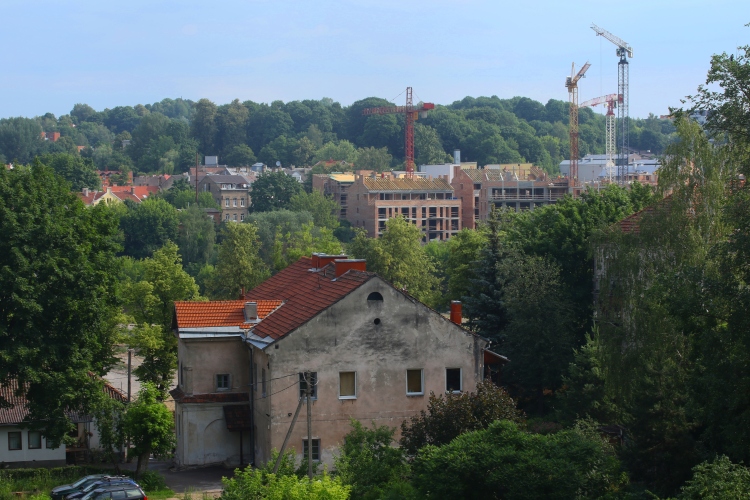 Along the left bank of the Vilnia river lies a stretch of the city centre that is virtually abandoned, known as “riverside” or Paupys. Wedged between the six-lane motorway that leads out to the Eastern suburb Naujoji Vilnia and the rapids of the Vilnia river lies a blind spot that used to be the site of Soviet-era factories, but is now starting to sprout new buildings. The plan is to make the most of this slice of old industrial land, which lies a stone’s throw from the old town and across the river from the boheme-bourgeois Užupis, and construction is in full swing to turn Paupys into a top-flight apartment zone. According to the prospectus of the company developing the site, the aim is to recapture some of the old charm of Paupys, when it used to be the site of fish farms, monasteries and mills, and blend it with its industrial heritage and modern apartment blocks. Let’s see if it works out, but it is fair to assume that in a few years, Paupys will not be a place people just drive past, but also spend some time in. But let it settle in a bit, because at the moment it is just a heaving construction site of muddy roads, huge trucks and burly men in hi-viz vests.
Along the left bank of the Vilnia river lies a stretch of the city centre that is virtually abandoned, known as “riverside” or Paupys. Wedged between the six-lane motorway that leads out to the Eastern suburb Naujoji Vilnia and the rapids of the Vilnia river lies a blind spot that used to be the site of Soviet-era factories, but is now starting to sprout new buildings. The plan is to make the most of this slice of old industrial land, which lies a stone’s throw from the old town and across the river from the boheme-bourgeois Užupis, and construction is in full swing to turn Paupys into a top-flight apartment zone. According to the prospectus of the company developing the site, the aim is to recapture some of the old charm of Paupys, when it used to be the site of fish farms, monasteries and mills, and blend it with its industrial heritage and modern apartment blocks. Let’s see if it works out, but it is fair to assume that in a few years, Paupys will not be a place people just drive past, but also spend some time in. But let it settle in a bit, because at the moment it is just a heaving construction site of muddy roads, huge trucks and burly men in hi-viz vests.